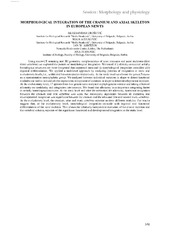Приказ основних података о документу
Morphological integration of the cranium and axial skeleton In European newts
| dc.creator | Urošević, Aleksandar | |
| dc.creator | Ajduković, Maja | |
| dc.creator | Jan Willem, Arntzen | |
| dc.creator | Ivanović, Ana | |
| dc.date.accessioned | 2019-11-08T08:40:40Z | |
| dc.date.available | 2019-11-08T08:40:40Z | |
| dc.date.issued | 2019 | |
| dc.identifier.isbn | 979-12-200-5284-9 | |
| dc.identifier.uri | http://seh-congress-2019.unipv.it/wp-content/uploads/2019/08/SEHXX-abstract-book-3.pdf | |
| dc.identifier.uri | https://radar.ibiss.bg.ac.rs/handle/123456789/3496 | |
| dc.description.abstract | Using micro-CT scanning and 3D geometric morphometrics of newt craniums and axial skeletons (first three vertebrae) we explored the pattern of morphological integration. We tested if i) directly connected serially homologous structures are more integrated than separated ones and ii) morphological integration coincides with regional differentiation. We applied a multilevel approach by analyzing patterns of integration at static and evolutionary levels, i.e., within and between species respectively. At the static level we choose the genus Triturus as a representative monophyletic group. We analysed between-individual variation in shape to detect functional modules and within-individuals the asymmetric component of variation in shape to detect developmental modules. At the evolutionary level, 17 species from five genera were analysed in phylogenetic context and taking effects of allometry on modularity and integration into account. We found that allometry is an important integrating factor in serially homologous structures. At the static level and after the correction for allometry, functional integration between the cranium and first vertebrae was weak but statistically significant between all elements, and developmental integration was significant between the cranium and the atlas and first and second trunk vertebrae. At the evolutionary level, the cranium, atlas and trunk vertebrae separate as three different modules. Our results suggest that, at the evolutionary level, morphological integration coincide with regional and functional differentiation of the axial skeleton. This allows the relatively independent evolution of the cranial skeleton and the vertebral column, separate of the significant functional and developmental integration at the static level. | en |
| dc.language.iso | en | sr |
| dc.publisher | Milan, Italy: University of Milan, the University of Pavia, the Natural History Museum of Milan and the University of Milano-Bicocca | sr |
| dc.relation | info:eu-repo/grantAgreement/MESTD/Basic Research (BR or ON)/173043/RS// | sr |
| dc.rights | openAccess | sr |
| dc.source | XX European Congress of Herpetology. Program & Abstracts; 2019 Sep 2-6; Milan, Italy | sr |
| dc.title | Morphological integration of the cranium and axial skeleton In European newts | en |
| dc.type | conferenceObject | sr |
| dc.rights.license | ARR | sr |
| dcterms.abstract | Јан Wиллем, Aрнтзен; Ивановић, Aна; Aјдуковић, Маја; Урошевић, Aлександар; | |
| dc.rights.holder | University of Milan, the University of Pavia, the Natural History Museum of Milan and the University of Milano-Bicocca | sr |
| dc.citation.spage | 142 | |
| dc.type.version | publishedVersion | sr |
| dc.identifier.fulltext | https://radar.ibiss.bg.ac.rs/bitstream/id/5561/SEHXX-abstract-book-3-pages-143.pdf | |
| dc.identifier.rcub | https://hdl.handle.net/21.15107/rcub_ibiss_3496 |

